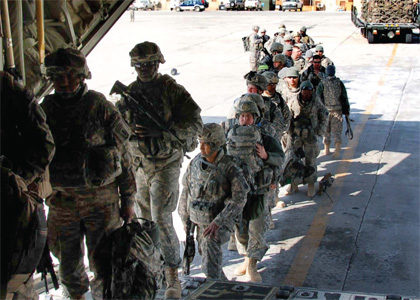Northern Distribution Network to shore up Afghan supply chain

The U.S. military may be winding down its operations in Iraq, but it's a whole different story in Afghanistan. Shortly after taking office in 2009, President Obama ordered the deployment of an additional 21,000 troops to Afghanistan. That number swelled to more than 30,000 over the following months, and in December, the president ordered another 30,000 troop bump by the summer of 2010. That will push the total to an estimated 98,000 U.S. troops, almost triple the number stationed in that country when President Bush left office.
The troop increase in Afghanistan might look manageable compared with the peak deployment in Iraq, which has been estimated at 170,000. But there's a lot more to the story than the numbers. In fact, looked at from a purely logistics perspective, military officials say, Afghanistan in many ways represents a worst-case scenario.
To begin with, there's the sheer volume of material that has to be brought in to support Afghan operations. Because Afghanistan offers little in the way of basic infrastructure, the military has to build things like housing. That means that in addition to moving people and their equipment into the country, it also has to bring in construction materials, food, medicine, and munitions, along with support contractors and everything else needed to survive in one of the most difficult environments on earth. Then there's the challenge of finding a way to bring all that stuff into the country. Afghanistan has only 16 airports with paved runways, and only four are capable of handling international cargo traffic. There are no seaports—it is a landlocked nation. And there are no railroads in.
Under the circumstances, it's little surprise that military logisticians consider providing support to troops in Afghanistan to be the ultimate test. "If you [were asked] where's the last place you'd like to be fighting a war, other than Antarctica, you might well pick Afghanistan [for its] landlocked, very austere environment," said Dr. Ash Carter, under secretary of defense for acquisition, technology, and logistics, at a recent conference on defense logistics modernization in Washington, D.C.
No entrance
In the absence of solid alternatives, the U.S. military has been forced to rely mainly on roads to bring supplies into Afghanistan. But the situation there isn't much better. Because the United States is barred from moving goods through Iran, points of entry into Afghanistan by ground are limited to a handful of mountain passes.
Until very recently, the only ground route judged usable by the United States and NATO was one that went in by way of Pakistan. After the fall of the Taliban government in 2002, the United States began sending truckloads of supplies picked up at Pakistan's Port of Karachi into Afghanistan through the Khyber Pass. At the time, the Khyber Pass was considered to be much safer than the alternative, a crossing in the Hindu Kush mountains at a town called Spin Boldak.
But the military has since been forced to revise its assessment of security on the Khyber Pass route (as military leaders often quip, "The enemy gets a vote."). In December 2008, 12 percent of the Afghanistan-bound freight crossing Pakistan's Northwest Frontier Province en route to the Khyber Pass disappeared, most of it in flames, according to Vice Adm. Mark Harnitchek, deputy commander of the U.S. Transportation Command.
The attacks on the freight convoys led logisticians to reroute shipments destined for the southern part of Afghanistan to the crossing at Spin Boldak. But Spin Boldak hasn't proved much better where security is concerned. On Aug. 30, 2009, a NATO convoy was attacked, and 20 fuel tankers and other supply trucks were destroyed.
The search for Plan B
Given the risks presented by the Pakistan ground routes, it's probably no surprise that the U.S. Central Command (CENTCOM) has been actively seeking other options. In 2008—well before the surge—Gen. Duncan McNabb, the commander of the U.S. Transportation Command, handed down orders directing the Surface Deployment and Distribution Command (SDDC) to start working with CENTCOM to find alternatives.
To understand what happened next, you have to know something about how military logistics has changed since the end of the Cold War. What many people don't realize is that the military is no longer in the business of moving freight. When it has cargo to move, it does exactly what a lot of its private-sector counterparts do—it hires a common carrier. "We have a worldwide presence without owning a truck, or a train, or a ship," says Maj. Gen. Jim Hodge, the commander of SDDC. "We do it all through our commercial partners."
So when it came time to get the project rolling, the military's first move was to get in touch with some of those commercial partners. "We decided to call in the guys who do this for a living and leverage them the best we could," says Col. Stan Wolosz, the SDDC's chief of staff. Military personnel quickly began contacting some of their primary carrier partners—including Maersk Line Ltd., APL, and Hapag-Lloyd—to solicit their help. As Kevin Speers, Maersk's senior director of marketing and administration, recalls, the central question the military posed to them was: "How can we bring in cargo overland to Afghanistan without touching Pakistan or Iran?"
The New Silk Road
What the military and its partners came up with is what's now known as the Northern Distribution Network (NDN), a set of multimodal routings that enter Afghanistan from the North, bypassing Pakistan completely. In some cases, these journeys incorporate parts of the old trade routes used for centuries by merchants, explorers, and warriors—routes collectively known as the Silk Road.
Although the partners identified nine options in total, most are variations on two basic approaches. One route crosses the Baltic Sea to Riga in Latvia, where the freight is loaded onto rail for the journey through Russia, Kazakhstan, and Uzbekistan, where it's offloaded onto trucks and hauled into Afghanistan.
The other route goes east through the Mediterranean and up the Dardanelles into the Black Sea, with the freight offloaded to rail at Tbilisi in Georgia. The cargo then moves overland through Georgia, Armenia, and Azerbaijan, before being loaded onto ships again at Baku for passage across the Caspian Sea to Kazakhstan. In Kazakhstan, it's loaded back onto rail for movement to Uzbekistan, where it's ultimately offloaded to trucks and hauled into Afghanistan.
The main destination hubs for cargo rolling into Afghanistan from the north are Bagram Air Force Base, Kabul, and Kandahar. In total, there are 32 direct delivery locations in Afghanistan.
As daunting as it might sound, coordinating the various legs of these complex multimodal moves is only part of the challenge. The other part is working with the various jurisdictions involved to make sure the shipments comply with each country's rules and requirements. "You have to tie together the governments, the carriers, the shipper, and the ground force," says Col. Wolosz. To help smooth the process, SDDC has taken the step of placing liaison officers in consulates and embassies across the NDN.
Mission accomplished
The first shipment to move via one of the northern routes departed in February 2009 and was delivered in May. Based on the success of that venture, the NDN was declared operational in May 2009, less than a year after the project began. As of the end of March 2010, over 10,000 containers had moved through this new set of routes.
The primary user of the NDN, which is reserved for non-lethal supplies, is the Defense Logistics Agency (DLA). So far, that agency alone has moved more than 8,000 containers through the network. "I think it has gone very well," says Air Force Col. Deirdre Mahon, the DLA's division chief for combatant command support. "Through time, the NDN has proven to be very reliable. We've seen the transit time continue to decrease and the capacity continue to increase. It's doing the job it was intended to do."
One of those jobs, of course, was to reduce the volume of freight brought in through Pakistan. And on that count, the project has been an unqualified success. Today, less than half of all Afghanistan-bound freight moves through Pakistan.
Alan Estevez, the principal deputy assistant secretary of defense (logistics & materiel readiness), credits the private sector with much of that success. "We could not do this without the great support we have from the contractor community, our partners, and transportation providers through some third-party logistics providers," he says.
The military has come in for its share of praise as well. "It's worked very well because whenever we've had an issue, we've been able to go right back to SDDC for help," says Rick Boyle, vice president, U.S.-flag transportation services at Maersk Line Ltd. "Together, we have an ability to get things done very quickly."
Related Articles

Copyright ©2024. All Rights ReservedDesign, CMS, Hosting & Web Development :: ePublishing